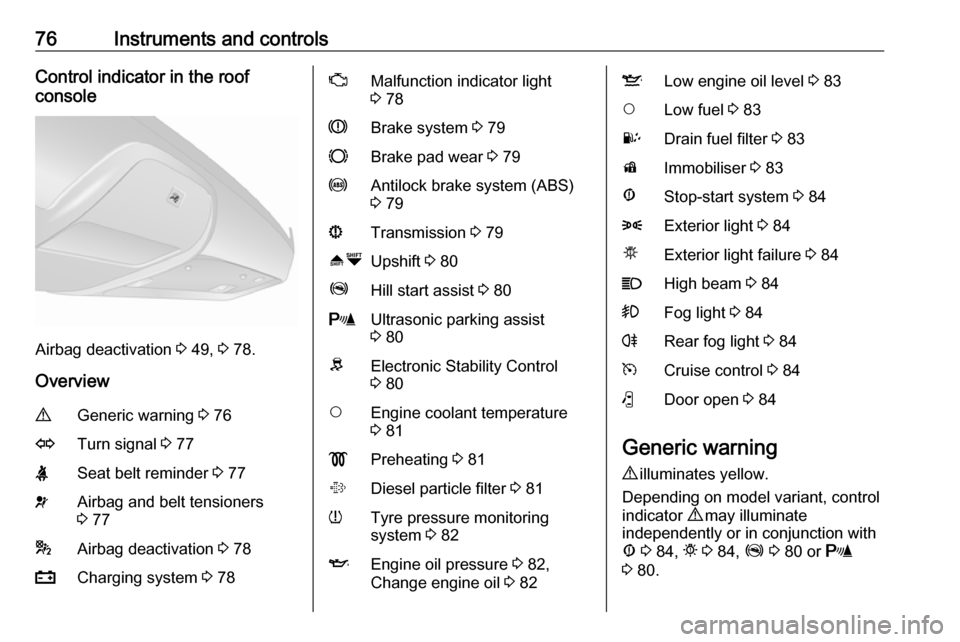park assist VAUXHALL COMBO 2016 Owner's Manual
[x] Cancel search | Manufacturer: VAUXHALL, Model Year: 2016, Model line: COMBO, Model: VAUXHALL COMBO 2016Pages: 189, PDF Size: 4.47 MB
Page 66 of 189

64Instruments and controlsInstruments and
controlsControls ....................................... 65
Steering wheel adjustment ........65
Steering wheel controls .............65
Horn ........................................... 65
Windscreen wiper/washer .........66
Rear window wiper/washer .......66
Headlamp washer .....................67
Outside temperature ..................67
Clock ......................................... 67
Power outlets ............................. 68
Cigarette lighter ......................... 69
Ashtrays .................................... 70
Warning lights, gauges and indi‐ cators ........................................... 70
Instrument cluster ......................70
Speedometer ............................. 70
Odometer .................................. 70
Trip odometer ............................ 70
Tachometer ............................... 71
Fuel gauge ................................ 71
Fuel selector .............................. 72
Engine coolant temperature gauge ....................................... 72
Service display .......................... 73Transmission display .................73
Control indicators ......................73
Generic warning ........................76
Turn signal ................................. 77
Seat belt reminder .....................77
Airbag and belt tensioners .........77
Airbag deactivation ....................78
Charging system .......................78
Malfunction indicator light ..........78
Brake system ............................. 79
Brake pad wear ......................... 79
Antilock brake system (ABS) .....79
Transmission ............................. 79
Upshift ....................................... 80
Hill start assist ........................... 80
Ultrasonic parking assist ...........80
Electronic Stability Control ........80
Engine coolant temperature ......81
Preheating ................................. 81
Diesel particle filter ....................81
Tyre pressure monitoring system ...................................... 82
Engine oil pressure ....................82
Change engine oil .....................82
Low engine oil level ...................83
Low fuel ..................................... 83
Drain fuel filter ........................... 83
Immobiliser ................................ 83
Stop-start system ......................84
Exterior light .............................. 84High beam................................. 84
Fog light ..................................... 84
Rear fog light ............................. 84
Cruise control ............................ 84
Door open .................................. 84
Information displays .....................85
Driver Information Centre ..........85
Vehicle messages ........................90
Warning chimes .........................90
Fuel system messages ..............91
Trip computer ............................... 91
Page 78 of 189

76Instruments and controlsControl indicator in the roof
console
Airbag deactivation 3 49, 3 78.
Overview
9Generic warning 3 76OTurn signal 3 77XSeat belt reminder 3 77vAirbag and belt tensioners
3 77*Airbag deactivation 3 78pCharging system 3 78ZMalfunction indicator light
3 78RBrake system 3 79FBrake pad wear 3 79uAntilock brake system (ABS)
3 79sTransmission 3 79[ ÒUpshift 3 80ZHill start assist 3 80rUltrasonic parking assist
3 80RElectronic Stability Control
3 80$Engine coolant temperature
3 81!Preheating 3 81%Diesel particle filter 3 81wTyre pressure monitoring
system 3 82IEngine oil pressure 3 82,
Change engine oil 3 82SLow engine oil level 3 83$Low fuel 3 83UDrain fuel filter 3 83dImmobiliser 3 83ÆStop-start system 3 848Exterior light 3 84µExterior light failure 3 84CHigh beam 3 84>Fog light 3 84rRear fog light 3 84mCruise control 3 84(Door open 3 84
Generic warning
9 illuminates yellow.
Depending on model variant, control
indicator 9 may illuminate
independently or in conjunction with
Æ 3 84, t 3 84, Z 3 80 or r
3 80.
Page 81 of 189

Instruments and controls79Flashes when the engine is
running
Fault that could lead to catalytic
converter damage. Ease up on the accelerator until the flashing stops.
Seek the assistance of a workshop
immediately.
Depending on version, a warning
message may also be displayed in
the Driver Information Centre (DIC)
3 85.
Brake system
R illuminates red.
Illuminates after the ignition is
switched on if the parking brake is
applied 3 119. A warning chime will
sound if a certain speed is exceeded
with the parking brake applied.
Illuminates when the parking brake is
released if the brake fluid level is too
low 3 137.9 Warning
Stop. Do not continue your
journey. Consult a workshop.
Illuminates if the brake vacuum servo
fails; the brake pedal becomes stiff
when pressed. The brake system
remains operational however,
assistance will be reduced. The
steering may also require
considerably more effort when
turning.
Depending on version, a warning
message may also be displayed in
the Driver Information Centre (DIC) 3 85.
Brake pad wear
F illuminates yellow.
The front brake pads are worn, seek
the assistance of a workshop
immediately.
Depending on version, a warning
message may also be displayed in
the Driver Information Centre (DIC)
3 85.
Antilock brake system
(ABS)
u illuminates yellow.Illuminates for a few seconds after the
ignition is switched on. The system is
ready for operation when the control
indicator extinguishes.
If the control indicator does not
extinguish after a few seconds, or if it illuminates while driving, there is a
fault in the ABS. The brake system
remains operational but without ABS
regulation.
If u illuminates together with R,
there is a fault in the braking system.
Depending on version, a warning
message may also be displayed in
the Driver Information Centre (DIC)
3 85. Seek the assistance of a
workshop immediately.
Antilock brake system 3 119.
Transmission
s illuminates red.
Illuminates for a few seconds after the ignition is switched on.
s illuminates during driving when a
fault is present in the transmission.
Page 82 of 189

80Instruments and controlsA warning message may also appear
in the Driver Information Centre (DIC)
3 85 in conjunction with a warning
chime.
Continued driving is possible,
provided the vehicle is driven with
care and anticipation.
Have the cause of the fault remedied
by a workshop as soon as possible.
Manual transmission automated
3 115.
Upshift
[ or Ò illuminates green in the
Driver Information Centre (DIC)
3 85 when gearshifting is
recommended to improve fuel
economy.
Hill start assistZ illuminates yellow.
Illuminates for a few seconds after the ignition is switched on.
If the control indicator does not
extinguish after a few seconds, or if it
illuminates while driving, there is afault in the Hill start assist. Seek the
assistance of a workshop to have the
fault remedied.
The Electronic Stability Control (ESC) control indicator R may also
illuminate 3 80 in conjunction with
Z .
Depending on version, 9 may
illuminate as an alternative if control
indicator Z is not present, in
conjunction with a warning message
in the Driver Information Centre (DIC)
3 85.
Generic warning 9 3 76.
Hill start assist 3 120.
Ultrasonic parking assist r illuminates yellow.
Fault in system
or
Fault due to sensors that are dirty or
covered by ice or snow
orInterference due to external sources
of ultrasound. Once the source of
interference is removed, the system
will operate normally.
Have the cause of the fault in the
system remedied by a workshop.
Control indicator 9 will illuminate as
an alternative if control indicator r
is not present. Depending on version,
a warning message may also be
displayed in the Driver Information
Centre (DIC) 3 85.
Generic warning 9 3 76.
Ultrasonic parking assist 3 124.
Electronic Stability Control
R illuminates or flashes yellow.
Illuminates for a few seconds after the
ignition is switched on. The system is ready for operation when the control
indicator extinguishes.
Flashes during driving
The system is actively engaged.
Engine output may be reduced and the vehicle may be braked
automatically to a small degree.
Page 92 of 189

90Instruments and controlsappears in the display. Select YES (to
confirm changes) or No (to cancel
changes).
Airbag deactivation 3 49.
DAYTIME RUNNING LIGHTS
Activate the daytime running lights to
increase visibility of the vehicle during daylight (set to On). Deactivate when
not required (set to Off).
Daytime running lights 3 95.
EXIT MENU
Select this menu option to exit the
settings menu.Vehicle messages
Warning chimes Only one warning chime will sound at
a time.
The warning chime regarding
unfastened seat belts has priority
over any other warning chime.
When starting the engine or whilst
driving
● If seat belt is not fastened.
● If a certain speed is exceeded with the parking brake applied.
● If the parking assist detects an object.
● If a fault is detected in the parking
assist.
● If a door, the bonnet or the tailgate is not fully closed when
starting-off.
● If the vehicle speed briefly exceeds a set limit.
● If the stop-start system cannot restart the engine automatically.● Vehicles with manual transmission automated; brake
pedal has not been depressed
when starting the engine.
● Vehicles with manual transmission automated; an
incorrect gear has been selected when starting-off or during
driving.
● Vehicles with manual transmission automated; whenthe vehicle is at a standstill, if
engine is running and a gear is
engaged; transmission
automatically shifts to N in certain
situations.
● If the clutch temperature is too high in vehicles with manual
transmission automated.
● If a transmission fault is detected
in vehicles with manual
transmission automated.
● If a warning message, e.g. low tyre pressure, appears in the
Driver Information Centre (DIC).
Page 109 of 189

Driving and operating107Driving and
operatingDriving hints ............................... 107
Control of the vehicle ...............107
Steering ................................... 107
Starting and operating ...............108
New vehicle running-in ............108
Ignition switch positions ...........108
Starting the engine ..................109
Vehicle shutdown ....................109
Overrun cut-off ........................ 110
Stop-start system ....................110
Parking .................................... 112
Engine exhaust .......................... 113
Diesel particle filter ..................113
Catalytic converter ...................114
Manual transmission ..................114
Manual transmission automa‐ ted .............................................. 115
Transmission display ...............115
Starting the engine ..................115
Selector lever .......................... 116
Manual mode ........................... 117
Electronic driving programmes 118
Fault ........................................ 118Brakes........................................ 119
Antilock brake system .............119
Parking brake .......................... 119
Brake assist ............................. 120
Hill start assist ......................... 120
Ride control systems .................121
Traction Control system ..........121
Electronic Stability Control ......121
Driver assistance systems .........122
Cruise control .......................... 122
Parking assist .......................... 124
Fuel ............................................ 125
Fuel for petrol engines .............125
Fuel for diesel engines ............126
Fuel for natural gas operation . 126
Refuelling ................................ 127
Fuel consumption - CO 2-
Emissions .............................. 129
Trailer hitch ................................ 130
General information .................130
Driving characteristics and towing tips .............................. 130
Trailer towing ........................... 130Driving hints
Control of the vehicle
Never coast with engine not
running (except during Autostop)
Many systems will not function in this
situation (e.g. brake servo unit, power
steering). Driving in this manner is a
danger to yourself and others. All
systems function during an Autostop,
but there will be a controlled reduction in power steering assist and vehicle
speed is reduced.
Stop-start system 3 110.
Pedals
To ensure the pedal travel is
uninhibited, there must be no mats in the area of the pedals.
Steering
If power steering assist is lost
because the engine stops or due to a system malfunction, the vehicle can
be steered but may require increased
effort.
Page 114 of 189

112Driving and operatingRestarting the engine
Manual transmission
The selector lever must be in neutral
to enable an automatic restart.
Depress the clutch pedal to restart the
engine.
Manual transmission automated
If the lever is in position N, select
another gear, otherwise release the
brake pedal or move the lever to +, –
or R to enable an automatic restart.
If an electrical accessory, e.g. a
portable CD player, is connected to
the power outlet, a brief power drop
during the restart may be noticeable.
Restarting the engine with the key When one of the following conditions
occurs during an Autostop, the
engine will need to be restarted
manually using the key.
● the driver's seat belt is unfastened and the driver's door
is opened
● three minutes have elapsed since the engine was switched offIn this event, control indicator ^
flashes in the DIC in conjunction with
a warning chime. Depending on
version, a corresponding message
may also appear in the DIC 3 85.
Fault
If control indicator Æ illuminates in the
instrument cluster, there is a fault in
the stop-start system 3 84.
Depending on version, 9 will
illuminate as an alternative if control
indicator Æ is not present. A warning
message may also be displayed in
the DIC 3 85.
Generic warning 9 3 76.
Seek the assistance of a workshop.
Parking9 Warning
● Do not park the vehicle on an
easily ignitable surface. The
high temperature of the
exhaust system could ignite the
surface.
● Always apply parking brake without pressing release
button. Apply as firmly as
possible on a downhill slope or
uphill slope. Depress brake
pedal at the same time to
reduce operating force.
● Switch off the engine. Turn the ignition key to position 0 and
remove it. Turn the steering
wheel until the steering wheel
lock is felt to engage.
● If the vehicle is on a level surface or uphill slope, engage
first gear before switching off
the ignition. On an uphill slope,
turn the front wheels away from
the kerb.
If the vehicle is on a downhill
slope, engage reverse gear
before switching off the ignition. Turn the front wheels towardsthe kerb.
Lock the vehicle 3 21 and activate the
anti-theft locking system 3 26 .
Page 121 of 189

Driving and operating119Brakes
The brake system comprises two
independent brake circuits.
If a brake circuit fails, the vehicle can
still be braked using the other brake
circuit. However, braking effect is
achieved only when the brake pedal
is depressed firmly. Considerably
more force is needed for this. The
braking distance is extended. Seek the assistance of a workshop before
continuing your journey.
When the engine is not running, the
support of the brake servo unit
disappears once the brake pedal has
been depressed once or twice.
Braking effect is not reduced, but
braking requires significantly greater
force. It is especially important to bear this in mind when being towed.
Control indicator R 3 79.
Antilock brake system
Antilock brake system (ABS)
prevents the wheels from locking.ABS starts to regulate brake pressure as soon as a wheel shows a tendency to lock. The vehicle remains
steerable, even during hard braking.
ABS control is made apparent
through a pulse in the brake pedal
and the noise of the regulation
process.
For optimum braking, keep the brake
pedal fully depressed throughout the
braking process, despite the fact that
the pedal is pulsating. Do not reduce
the pressure on the pedal.
After starting off the system performs
a self-test which may be audible.
Control indicator u 3 79.
Fault9 Warning
If there is a fault in the ABS, the
wheels may be liable to lock due
to braking that is heavier than
normal. The advantages of ABS
are no longer available. During
hard braking, the vehicle can nolonger be steered and may
swerve.
Have the cause of the fault remedied
by a workshop.
Parking brake
Manual parking brake
Page 122 of 189

120Driving and operating9Warning
Always apply parking brake firmly
without operating the release
button, and apply as firmly as
possible on a downhill or uphill
slope.
To release the parking brake, pull
the lever up slightly, press the
release button and fully lower the
lever.
To reduce the operating forces of
the parking brake, depress the
brake pedal at the same time.
A warning chime will sound if a certain
speed is exceeded with the parking
brake applied.
Notice
The volume of the warning chime
can also be adjusted via the Driver
Information Centre (DIC) 3 85.
Control indicator R 3 79.
Brake assist
If the brake pedal is depressed
quickly and forcefully, maximum
brake force is automatically applied
(full braking).
Maintain steady pressure on the brake pedal for as long as full braking
is required. Maximum brake force is
automatically reduced when the
brake pedal is released.
Hill start assist
The system helps prevent unintended movement when driving away on
inclines.
When releasing the brake pedal after
stopping on an incline, the brakes
remain on for a further two seconds.
The brakes release automatically as
soon as the vehicle begins to
accelerate.
If control indicator Z illuminates
while driving, there is a fault in the Hill
start assist 3 80 . Seek the assistance
of a workshop to have the fault remedied.The Hill start assist is not active
during an Autostop.
Stop-start system 3 110.
Page 126 of 189

124Driving and operatingSwitching off
Turn end of lever to the OFF position;
control indicator m extinguishes. The
stored speed is deleted. Switching off
the ignition also deletes the stored
speed.
Parking assist
The parking assist makes parking
easier by measuring the distance between the vehicle and obstacles,
and giving acoustic signals. It is the
driver, however, who bears full
responsibility for the parking
manoeuvre.
The system consists of four ultrasonic parking sensors in the rear bumper.
Control indicator r 3 80.
System operation
The parking assist is turned on
automatically when reverse gear is engaged.
The intervals between the beeps
become shorter as the vehicle gets
closer to the obstacle. When the
distance is less than 30 cm, the beeping is a continuous tone whichstops immediately when the distance
is increased.
Fault
In the event of a fault in the system,
r illuminates and a message is
displayed in the Driver Information
Centre (DIC) 3 85.
The following conditions could affect
the system's performance:
● The ultrasonic sensors are not clean. Keep the bumper free of
mud, dirt, snow, ice and slush.
● The sensors are covered by frost
or ice.● The rear doors / tailgate are open.
● An object was hanging out of the
rear doors / tailgate during the
last drive cycle. Once the object
has been removed, the parking
assist will return to normal
operation.
● An object or cover is attached to the rear of the vehicle.
● The bumper is damaged. Take the vehicle to a workshop to
repair the system.
● Other conditions, such as vibrations from a jackhammer,
are affecting system
performance.
In the event the system still does not
work properly, seek the assistance of
a workshop.
A warning chime is also sounded
briefly if a fault is present when
reverse gear is engaged 3 90.
Notice
The volume of the warning chime
can also be adjusted via the Driver
Information Centre (DIC) 3 85.